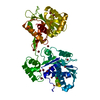+Search query
-Structure paper
| Title | Structural basis of DNA packaging by a ring-type ATPase from an archetypal viral system. |
|---|---|
| Journal, issue, pages | Nucleic Acids Res, Vol. 50, Issue 15, Page 8719-8732, Year 2022 |
| Publish date | Aug 26, 2022 |
 Authors Authors | Herman K H Fung / Shelley Grimes / Alexis Huet / Robert L Duda / Maria Chechik / Joseph Gault / Carol V Robinson / Roger W Hendrix / Paul J Jardine / James F Conway / Christoph G Baumann / Alfred A Antson /   |
| PubMed Abstract | Many essential cellular processes rely on substrate rotation or translocation by a multi-subunit, ring-type NTPase. A large number of double-stranded DNA viruses, including tailed bacteriophages and ...Many essential cellular processes rely on substrate rotation or translocation by a multi-subunit, ring-type NTPase. A large number of double-stranded DNA viruses, including tailed bacteriophages and herpes viruses, use a homomeric ring ATPase to processively translocate viral genomic DNA into procapsids during assembly. Our current understanding of viral DNA packaging comes from three archetypal bacteriophage systems: cos, pac and phi29. Detailed mechanistic understanding exists for pac and phi29, but not for cos. Here, we reconstituted in vitro a cos packaging system based on bacteriophage HK97 and provided a detailed biochemical and structural description. We used a photobleaching-based, single-molecule assay to determine the stoichiometry of the DNA-translocating ATPase large terminase. Crystal structures of the large terminase and DNA-recruiting small terminase, a first for a biochemically defined cos system, reveal mechanistic similarities between cos and pac systems. At the same time, mutational and biochemical analyses indicate a new regulatory mechanism for ATPase multimerization and coordination in the HK97 system. This work therefore establishes a framework for studying the evolutionary relationships between ATP-dependent DNA translocation machineries in double-stranded DNA viruses. |
 External links External links |  Nucleic Acids Res / Nucleic Acids Res /  PubMed:35947691 / PubMed:35947691 /  PubMed Central PubMed Central |
| Methods | EM (single particle) / X-ray diffraction |
| Resolution | 1.4 - 22.0 Å |
| Structure data |  EMDB-22099:  EMDB-22100:  EMDB-22101:  PDB-6z6d:  PDB-6z6e: |
| Chemicals |  ChemComp-BR:  ChemComp-HOH:  ChemComp-IOD: |
| Source |
|
 Keywords Keywords | VIRAL PROTEIN / genome packaging / bacteriophage / ATPase / nuclease / DNA binding |
 Movie
Movie Controller
Controller Structure viewers
Structure viewers About Yorodumi Papers
About Yorodumi Papers



 enterobacteria phage hk97 (virus)
enterobacteria phage hk97 (virus)